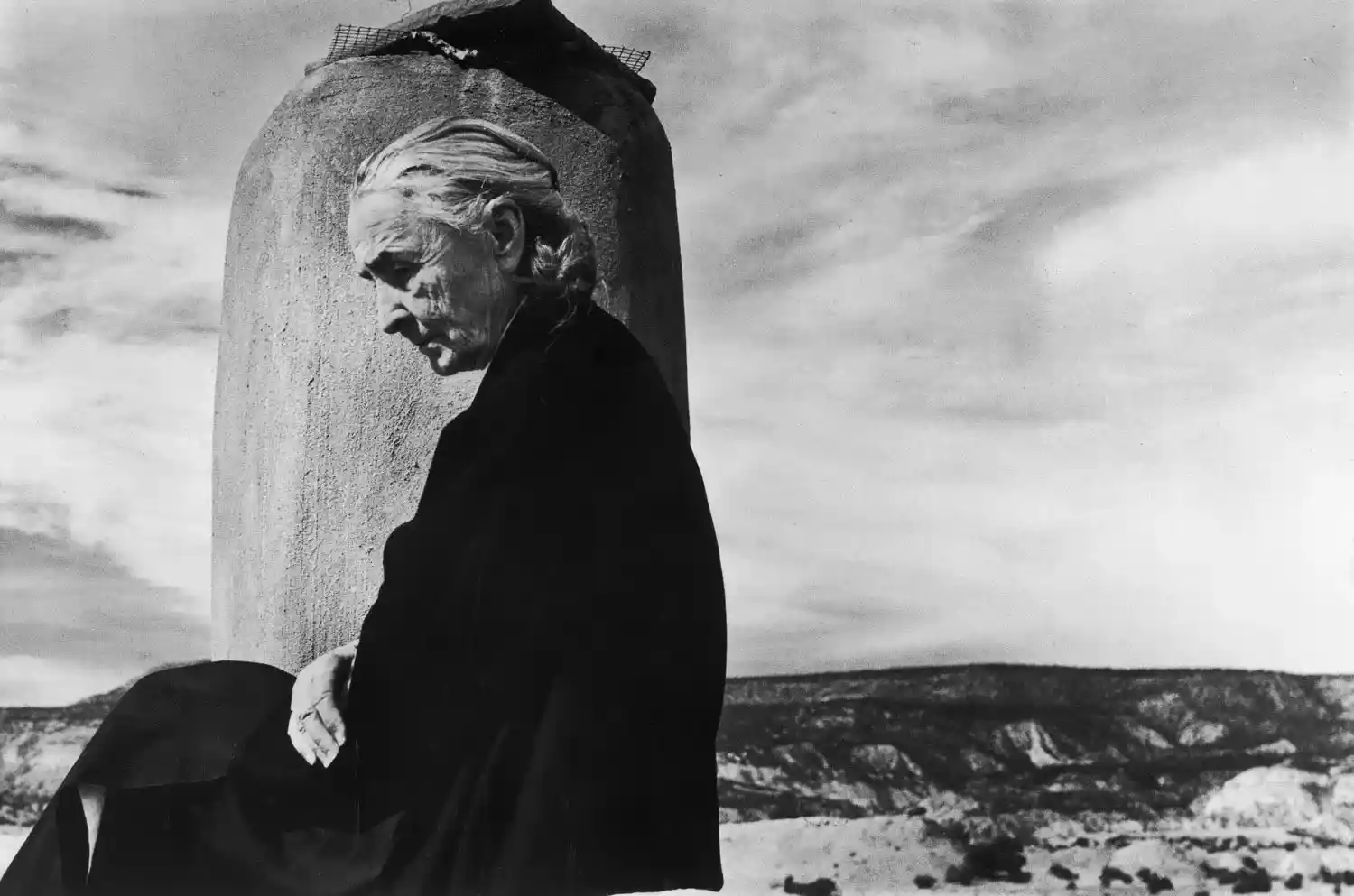Table of Contents
Georgia O’Keeffe was more than just a well-known figure in the art world; she was a natural force. She was born in Wisconsin in 1887 and consistently went above and above.
In contrast to the women of her era, who were generally expected to keep to the confines of home life or produce delicate watercolors, O’Keeffe took a more adventurous route. She made the abstract feel intimate.
She made flowers speak, bones whisper, and deserts sing. Her work demanded attention rather than requesting it.
O’Keeffe’s work covered a large portion of the 20th century, and she was the first female painter to be regarded in New York’s modernist scene.
She didn’t merely smash borders; she dissolved them with her striking hues and seductive contours. However, as she grew older, her narrative changed from one of a fearless trailblazer to one of a timid genius who lived far away from the masses.
Even though a large portion of her life has been honored, the account of her last days provides a profoundly poignant glimpse into the lady who created the masterpieces.
Why Her Death Still Resonates Today?
Why is O’Keeffe’s passing still being discussed almost forty years later? Because her death signified the end of a chapter in American culture, not just the death of an individual.
Our views of nature, femininity, and ourselves were altered by her art. We stop when someone who changed the story passes away.
Her death was quiet—almost poetic. No commotion, no dispute. It faded slowly, like the sun lowering behind one of her favorite mesas in New Mexico.
However, there is something potent in that silence—the sort of conclusion that only a fully self-possessed individual can decide upon. Appreciating O’Keeffe’s full journey is more important than understanding how she passed away.
Georgia O’Keeffe’s Final Years
Living in New Mexico – The Desert as Her Refuge
By the time she was in her late seventies, Georgia O’Keeffe had withdrawn to the open regions of New Mexico. No metropolis could ever speak to her spirit the way the desert, with its untamed beauty and sharp contrasts, did.
Her time at Ghost Ranch and her adobe house in Abiquiu were more than just places; they were manifestations of who she was.
She had a modest life there, rising early, exploring the land, and continuing to produce art in one way or another nearly every day.
The desert had nourished her imagination for decades. But in her final years, it offered something different: solitude. Peace. Reflection. This was a chosen calm, not a lonely seclusion.
She rarely had guests, and her house was transformed into a hallowed, nearly monastic setting.
The desert’s quiet reflected the quiet she desired in her own life—away from the limelight, away from the commotion, away from everything save her own thoughts and the world she perceived within.
Read also: ToonX
Macular Degeneration and Fading Eyesight
Early in the 1970s, Georgia started to have vision issues that would eventually be identified as macular degeneration, a condition that damages the retina’s central region, gradually impairing and eventually destroying central vision.
This was a cruel turn of events for a painter whose life was devoted to observing the subtleties of color, form, and light. Instead, she adapted. She explored pottery.
To help her realize her creative dreams, she depended on helpers. Her spirit remained strong even as her body began to fail.
She perceived blindness as a shift, a change in medium rather than a change in purpose, when many would have seen it as an end.
Adapting Art Despite Physical Decline
Even as her eyesight failed, O’Keeffe’s creativity found new channels. She continued to create art using clay, pastels, and even dictating compositions with the assistance of intimate assistants, such as artist Juan Hamilton.
These were not her glory days in the public’s eyes, but to her, they were just another stage in a life of reinvention.
O’Keeffe once said, “I believe I would rather have Stieglitz [her husband] see me blind than idle and helpless.
” That sentiment captures her entirely resilient, driven, and fiercely independent. Her late work, though sparse, has a raw intimacy to it. It’s as though you’re not just looking at a piece of art—you’re looking at the thoughts of someone staring mortality in the face and refusing to blink.
The Day Georgia O’Keeffe Died
Her Death at St. Vincent Hospital
On March 6, 1986, Georgia O’Keeffe died at Santa Fe, New Mexico’s St. Vincent Hospital. She was ninety-eight. It ended gently, as calmly, deliberately, and without spectacle as she had in her final years.
There were no media frenzy or spectacular closing remarks. Just a serene departure from a world she had so powerfully interpreted through her art.
She was weak in those last days; her body having given in to the gradual but unrelenting consequences of aging. Those around her, however, were struck by the profound sense of calm.
It was almost as if she had made peace with everything—her life, her fame, her fading vision, and even death itself. There were no regrets. She was prepared to move on after leading a life filled with passion and purpose.
Cause of Death: What We Know and Don’t Know
Officially, O’Keeffe’s cause of death was attributed to natural causes. No major public medical statements were made. Some reports cite complications of aging and frailty.
Others hypothesize that other age-related illnesses and the advancement of macular degeneration might have played a role.
However, in keeping with her lifelong dedication to privacy, neither a thorough autopsy nor a medical report was made public.
And perhaps that’s fitting. O’Keeffe never lived up to the expectations of the public, and her death reflected those expectations. She had no obligation to provide an explanation.
She had already given it enough through her art. What is certain is that she passed away as she had lived, surrounded by the New Mexico scenery that had always served as her haven, on her own terms, and without fanfare or ceremony.
Her Wish for Privacy in Death
O’Keeffe was never comfortable with the celebrity that came with her success. She guarded her privacy with the same intensity that she poured into her canvases.
That desire for solitude extended into her death. She requested no public funeral, no memorial service, and no elaborate farewell.
In a world obsessed with spectacle, that silence was profound. It made a statement more powerful than words ever could: she didn’t need the applause.
Her legacy was already cemented in every gallery wall that displayed her work, in every artist who drew courage from her example, and in every viewer who saw something new in a flower or skull because of her.
What Happened After Her Death?
At Ghost Ranch, cremation and ash scattering
O’Keeffe’s remains were cremated, and a year after her passing, her ashes were scattered over for her, Ghost Ranch was more than just a place.
Ghost Ranch was more than a physical location for her. It was a spiritual haven, a landscape that had given her inspiration, identity, and peace.
The scattering of her ashes wasn’t publicized. There was no televised ceremony or crowded gathering. Instead, it was a quiet, deeply personal ritual carried out in accordance with her wishes.
Her ashes mingled with the red dust and wind of the land she had loved so fiercely. It was a perfect ending—intimate, timeless, and one with the earth.
Today, visitors still flock to Ghost Ranch, not just for the scenery but to feel closer to the essence of Georgia O’Keeffe. It remains one of the most powerful symbols of her legacy, and standing there, it’s easy to imagine her spirit still roaming the hills and cliffs she immortalized.
Public Reaction and Tributes
Though her passing was quiet, the world certainly felt it. When news of her death broke, tributes poured in from all over the globe. Artists, curators, historians, and everyday fans shared memories and reflections.
Major art institutions released statements praising her courage, originality, and the path she paved for women in art.
Newspapers and magazines ran obituaries not just as formal notices, but as love letters to a woman who had changed everything.
The New York Times called her a “visionary,” while art critics hailed her as “the lens through which America saw itself differently.” Museums organized retrospectives.
Universities held panels. And artists young and old took a moment to thank the woman who had shown them it was okay to see the world through a different lens.
Her Deep Bond with the Landscape
For Georgia O’Keeffe, Ghost Ranch wasn’t just a backdrop for paintings. Her entire emotional universe revolved around it. “That was mine when I got to New Mexico,” she once remarked.
As soon as I saw it, that was my country.” The stark mesas, vast skies, and sun-drenched cliffs didn’t just influence her work—they became a part of her soul.
She would often rise before dawn to hike alone, taking in the color shifts of the desert as the sun climbed higher. Every bone, rock, and flower she painted came from these explorations.
To O’Keeffe, the land was alive—it breathed, it pulsed, and it told stories. And she translated those stories into brushstrokes.
So, when it came time to decide her final resting place, there was never any question. Her ashes needed to be returned to the land that had given her so much.
In doing so, she didn’t just vanish. She became a permanent part of the place that shaped her vision and voice.
Why Ghost Ranch Was Her Spiritual Home?
Ghost Ranch was more than inspirational—it was transformational. It stripped away distractions and left only what mattered. In the desert’s stillness, O’Keeffe found clarity.
There was only space—no galleries, no agents, no critics. Room to see, to ponder, to create.
For decades, she returned to Ghost Ranch like a pilgrim returns to a temple.
And in death, she remained there. Her ashes scattered among the buttes and canyons were not just an act of remembrance. It was a sacred homecoming. She belonged to that land as much as it belonged to her.
Visitors today often describe a strange sense of calm when they stand where she once walked. Maybe it’s the silence. Maybe it’s the light. Perhaps it’s Georgia O’Keeffe herself, who is still observing and painting the horizon in her own intangible manner.
Final Words
Georgia O’Keeffe’s death was quiet, dramatic, and private—exactly like her life, which was solitary, deliberate, and intensely personal.
She was 98 years old, had witnessed unthinkable changes in the world, and had contributed to a transformation of our perceptions of nature, art, and the place of women in creative fields. She created history rather than merely seeing it.
Her death marked the end of a remarkable era. Her legacy, however, is far from over. O’Keeffe is present whenever someone feels something stir when they look at the silent strength of a desert cliff, the whirling heart of a flower, or the eerie edge of a skull.
She taught us that art could be personal and powerful, that solitude could be sacred, and that you don’t need to be loud to be heard.

